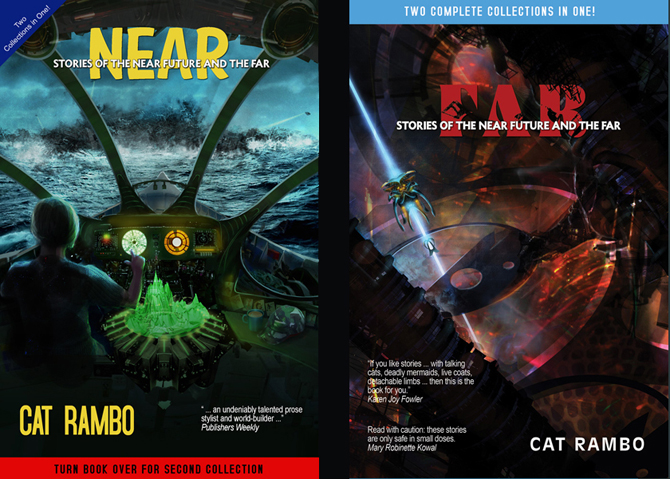Shimmering Kaleidoscopes: Cat Rambo’s Near + Far
Note: this is part of a series in which I discuss works of the contributors to The Other Half of the Sky. Other entries in the series appear at the end of each discussion.
Cat Rambo’s recent collection, Near + Far (Hydra House, $16.95 print, $6.99 digital), is a tête-bêche book containing 2×12 stories of wildly different lengths that previously appeared in such venues as Abyss and Apex, Clarkesworld, Clockwork Phoenix, Crossed Genres, Daily SF and Lightspeed.
Before I discuss the stories themselves, I’ll mention two secondary but important aspects of the book. One is the attention paid to the presentation; as one example, the text ornaments are almost distracting in their beauty. The other is that each story has an afterword in which Rambo gives its backstory and worldpath. Personally, I greatly enjoy such fore/afterwords (I still fondly recall Harlan Ellison’s needle-sharp, needling introductions) and find that they invariably deepen my understanding and appreciation of the tale – provided that the writer knows their craft. Which brings us to the content of the collection.
Cat Rambo is a chameleon – a type of writer as rare as a Hollywood actor who can submerge themselves into a character. Rambo’s range is galaxy-wide: she goes from near-future quasi-dystopia to far-future space opera, from slapstick humor to Eurypidean tragedy, with deceptively effortless prose, like a prima ballerina executing grandes jetés. She also has a flair for the telling snippet that brings a person or setting to sharp, vivid life, like the pass of a lighthouse beacon.
The Near and Far halves hew to their titles: the former keeps close to home in spacetime, the latter ventures further afield. Yet common kernels underlie these thematically and stylistically far-flung worlds: the complexity of relationships (the frictions of long-term pairings in particular) and, obversely, the urgent desire for connection even at a steep cost. Everything is scaled to personal dimensions, even in the space operas. There’s a noticeable transhumanist overlay to the cycle (AIs of various sentience levels and nanobiotech-based modifications are ubiquitous), though it never devolves to the tiresome paradise/hell binary. Instead, Rambo focuses on the dilemmas of autonomy, privacy and community. She also eschews neat resolutions. Most of the stories end ambiguously or remain open-ended; many are bleak, though in a pragmatic, low-key way that makes them poignant.
Several of the stories in Near are about failing connections. “Peaches of Immortality” is a downbeat version of Groundhog Day that renews the frisson associated with high school cliques. “Close Your Eyes” and “Not Waving but Drowning” are unflinching examinations of issues that corrode relationships: the friction between a sister taking care of her dying brother in the former, the unraveling of trust that results from excessive transparency in a marriage in the latter. “Therapy Buddha” and “Long Enough and Just So Long” are investigations into consciousness: the first illustrates the placebo effects of an ELIZA-type program; the second is Tanith Lee’s Silver Metal Lover shorn of its romantic trappings. “RealFur” is a story of suffocation on several levels whereas “Vocobox™” is about the loneliness of togetherness when the fit is bad.
My favorite stories in Near show harsh worlds where loyalty and companionship are nevertheless possible and make a difference. “The Mermaids Singing Each to Each” is a retelling of The Old Man and the Sea in a universe where gender fluidity is easy – and an AI can earn forgiveness for a betrayal. “Memories of Moments, Bright as Falling Stars” is what Strange Days could have been if Kathryn Bigelow had not pulled her punches about the repercussions of brain enhancements in a pyramidal-privilege society. “Legends of the Gone” portrays the world going out not with a bang, but with a whimper… yet its subdued notes are oddly consoling, perhaps because dying humanity has remained humane.
Heading for the antipodes, some of the Far stories are actually between Near and Far. Taking off from Near, “Zeppelin Follies” and “Surrogates” contemplate futures in which humans interact with the world through filtering devices. Landing at Far, “A Querulous Flute of Bone” and “Five Ways to Fall in Love on Planet Porcelain” explore desire in unique settings that are nevertheless reflections of our internal landscapes.
Far showcases Rambo’s prowess at creating intriguing, thought-provoking worlds and aliens. Several stories in Far delve into the longing to belong and also explore other senses beyond the dominant human one of vision. At the humorous end, “Kalakkak’s Cousins” is Deep Space 9 via Lucky Luke’s bumbling Dalton brothers. In the still-hopeful middle are “Seeking Nothing” and “Angry Rose’s Lament” whose misfit protagonists voluntarily choose submersion into group minds to allay loneliness. At the sorrowful end, “Amid the Words of War” shows a doomed alien outcast with surprisingly universal needs. Aliens of a different kind are depicted in “Timesnip” in which a time-transported suffragette catalyzes a revolution (actually, a restoration) in a planetfall society that has turned the Oedipal configuration into a requirement for male adulthood.
Far closes with “Bus Ride to Mars”, a slipstream version of the Canterbury Tales. However, the piece in Far that plucked a strong resonating chord in my mind was its opening: “Futures” is a flash story that encompasses all the universes in the anthology – plus many more. With its limpid, lapidary glimpsed views through doors held ajar, it’s the most evocative piece in the collection, the one that induces the yearning triggered only by the highest quality SF.
I’ve kept the descriptions of the stories in Near + Far deliberately brief and vague; they’re far more complex and intricate that these soundbites indicate. It’s my fond hope that the crumbs I dropped have made everyone hungry enough to devour the entire collection. It’s a generous, savory meal that rewards the discerning palate.
In the same series:
The Hard Underbelly of the Future: Sue Lange’s Uncategorized



